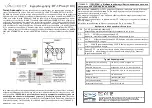
5
ATmega103(L)
0945G–09/01
Pin Descriptions
VCC
Supply voltage.
GND
Ground.
Port A (PA7..PA0)
Port A is an 8-bit bi-directional I/O port. Port pins can provide internal pull-up resistors
(selected for each bit). The Port A output buffers can sink 20 mA and can drive LED dis-
plays directly. When pins PA0 to PA7 are used as inputs and are externally pulled low,
they will source current if the internal pull-up resistors are activated.
Port A serves as Multiplexed Address/Data bus when using external SRAM.
The Port A pins are tri-stated when a reset condition becomes active, even if the clock is
not running.
Port B (PB7..PB0)
Port B is an 8-bit bi-directional I/O port with internal pull-up resistors. The Port B output
buffers can sink 20 mA. As inputs, Port B pins that are externally pulled low, will source
current if the pull-up resistors are activated.
Port B also serves the functions of various special features.
The Port B pins are tri-stated when a reset condition becomes active, even if the clock is
not running.
Port C (PC7..PC0)
Port C is an 8-bit output port. The Port C output buffers can sink 20 mA.
Port C also serves as Address output when using external SRAM.
Since Port C is an output only port, the Port C pins are
not
tri-stated when a reset condi-
tion becomes active.
Port D (PD7..PD0)
Port D is an 8-bit bi-directional I/O port with internal pull-up resistors. The Port D output
buffers can sink 20 mA. As inputs, Port D pins that are externally pulled low will source
current if the pull-up resistors are activated.
Port D also serves the functions of various special features.
The Port D pins are tri-stated when a reset condition becomes active, even if the clock is
not running.
Port E (PE7..PE0)
Port E is an 8-bit bi-directional I/O port with internal pull-up resistors. The Port E output
buffers can sink 20 mA. As inputs, Port E pins that are externally pulled low will source
current if the pull-up resistors are activated.
Port E also serves the functions of various special features.
The Port E pins are tri-stated when a reset condition becomes active, even if the clock is
not running
Port F (PF7..PF0)
Port F is an 8-bit input port. Port F also serves as the analog inputs for the ADC.
RESET
Reset input. An external reset is generated by a low level on the RESET pin. Reset
pulses longer than 50 ns will generate a reset, even if the clock is not running. Shorter
pulses are not guaranteed to generate a reset.
XTAL1
Input to the inverting oscillator amplifier and input to the internal clock operating circuit.
XTAL2
Output from the inverting oscillator amplifier.






































